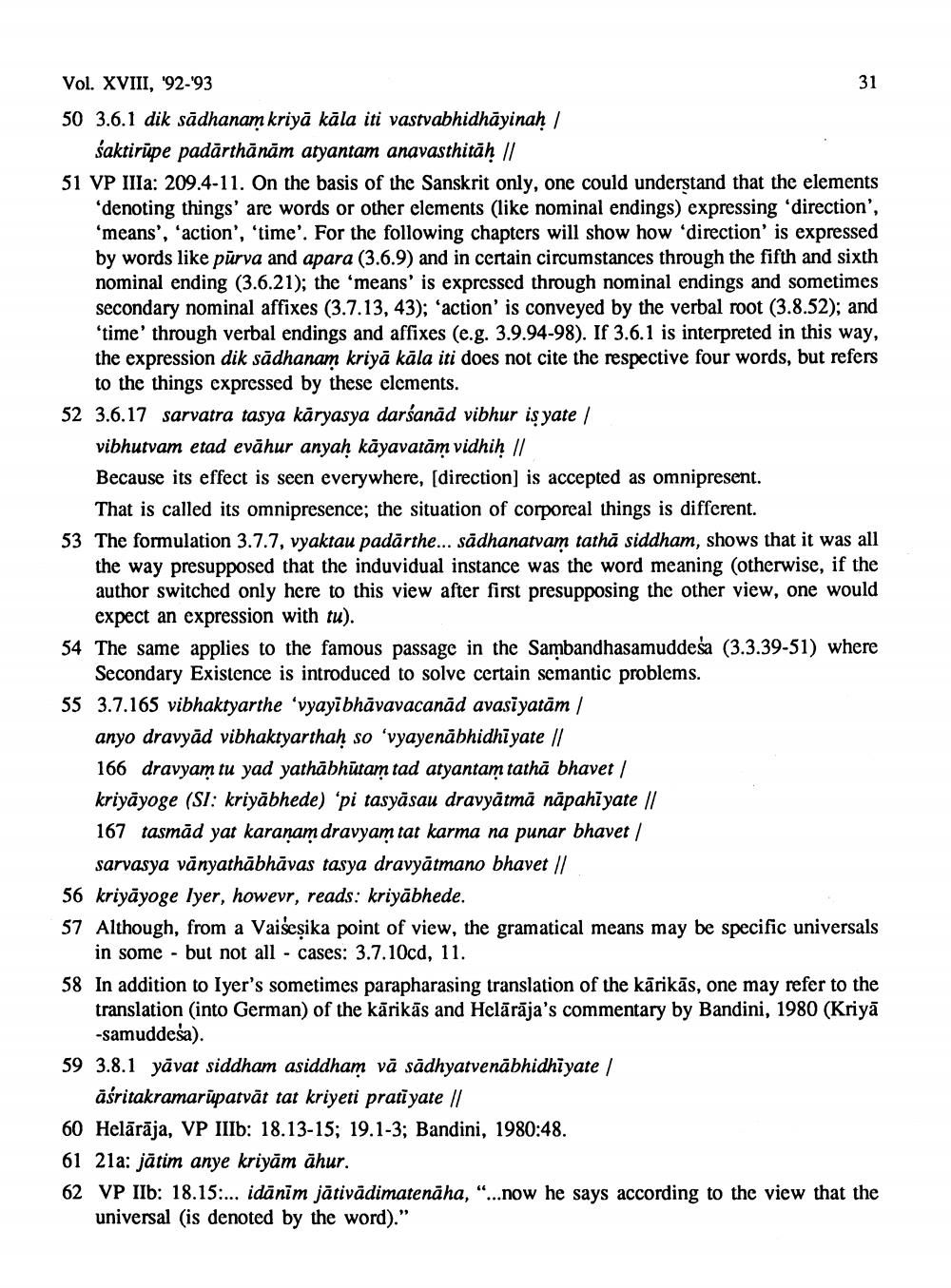________________
Vol. XVIII, 92-93
50 3.6.1 dik sadhanam kriyā kāla iti vastvabhidhāyinaḥ /
śaktiripe padarthānām atyantam anavasthitaḥ ||
51 VP IIIa: 209.4-11. On the basis of the Sanskrit only, one could understand that the elements 'denoting things' are words or other elements (like nominal endings) expressing 'direction', 'means', 'action', 'time'. For the following chapters will show how 'direction' is expressed by words like pūrva and apara (3.6.9) and in certain circumstances through the fifth and sixth nominal ending (3.6.21); the 'means' is expressed through nominal endings and sometimes secondary nominal affixes (3.7.13, 43); 'action' is conveyed by the verbal root (3.8.52); and 'time' through verbal endings and affixes (e.g. 3.9.94-98). If 3.6.1 is interpreted in this way. the expression dik sädhanam kriyā kāla iti does not cite the respective four words, but refers to the things expressed by these elements.
31
52 3.6.17 sarvatra tasya käryasya darśanad vibhur iş yate/
vibhutvam etad evähur anyaḥ kāyavatām vidhiḥ ||
Because its effect is seen everywhere, [direction] is accepted as omnipresent. That is called its omnipresence; the situation of corporeal things is different.
53 The formulation 3.7.7, vyaktau padarthe... sädhanatvam tathā siddham, shows that it was all the way presupposed that the induvidual instance was the word meaning (otherwise, if the author switched only here to this view after first presupposing the other view, one would expect an expression with tu).
54 The same applies to the famous passage in the Sambandhasamuddeśa (3.3.39-51) where Secondary Existence is introduced to solve certain semantic problems.
55 3.7.165 vibhaktyarthe 'vyayibhāvavacanād avasiyatām/
anyo dravyad vibhaktyarthaḥ so 'vyayenābhidhiyate ||
166 dravyam tu yad yathābhūtam tad atyantam tatha bhavet / kriyāyoge (SI: kriyābhede) 'pi tasyāsau dravyātmā nāpahiyate || 167 tasmad yat karanam dravyam tat karma na punar bhavet/ sarvasya vanyathābhāvas tasya dravyatmano bhavet ||
56 kriyayoge lyer, howevr, reads: kriyābhede.
57 Although, from a Vaiseșika point of view, the gramatical means may be specific universals in some but not all cases: 3.7.10cd, 11.
58 In addition to Iyer's sometimes parapharasing translation of the kārikās, one may refer to the translation (into German) of the kärikäs and Helārāja's commentary by Bandini, 1980 (Kriyā -samuddeśa).
59 3.8.1 yavat siddham asiddham vā sadhyatvenābhidhiyate /
äśritakramaripatvät tat kriyeti pratyate ||
60 Helārāja, VP IIIb: 18.13-15; 19.1-3; Bandini, 1980:48.
61 21a: jätim anye kriyām āhur.
62 VP IIb: 18.15:... idänīm jātivädimatenäha, "...now he says according to the view that the universal (is denoted by the word)."




